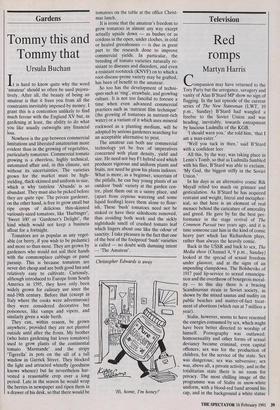Gardens
Tommy this and Tommy that
Ursula Buchan
It is hard to know quite why the word 'amateur' should so often be used pejora- tively. After all, the beauty of being an amateur is that it frees you from all the constraints inevitably imposed by money. I grant this is a contention unlikely to find much favour with the England XV but, in gardening at least, the ability to do what you like usually outweighs any financial loss.
Nowhere is the gap between commercial limitations and liberated amateurism more evident than in the growing of vegetables, particularly tomatoes. Commercial tomato growing is • a cheerless, highly technical, automated affair and, in this climate, not without its uncertainties. The varieties grown for the market must be high- yielding, thick-skinned and uniform in size, which is why tasteless `Abunda' is so abundant. They must also be picked before they are quite ripe. The private gardener, on the other hand, is free to grow small but ripe crops of delicious thin-skinned variously-sized tomatoes, like 'Harbinger', 'Sweet 100' or 'Gardener's Delight', the kind which would not keep a business afloat for a fortnight. Tomatoes are as popular as any veget- able (or berry, if you wish to be pedantic) and more so than most. They are grown by gardeners who would not soil their hands with the commonplace cabbage or passé parsnip. This is because tomatoes are never dirt cheap and are both good fun and relatively easy to cultivate. Curiously, although introduced to Europe from South America in 1595, they have only been widely grown for culinary use since the mid-19th century. Before that (except in Italy where the cooks were adventurous) they were considered decorative but poisonous, like vamps and vipers, and similarly given a wide berth. They can, within reason, be grown anywhere, provided they are not planted outside until after the frosts. My brother (who hates gardening but loves tomatoes) used to grow plants of the continental tomato `Marmande' and the stripy `Tigerella' in pots on the sill of a tall window in Garrick Street. They blocked the light and attracted whitefly (goodness knows whence) but he nevertheless har- vested a reasonable crop over a long period. Late in the season he would wrap the berries in newspaper and ripen them in a drawer of his desk, so that there would be tomatoes on the table at the office Christ- mas lunch.
It is ironic that the amateur's freedom to grow tomatoes in almost any way except actually upside down — as bushes or as cordons in the open, under cloches, in cold or heated greenhouses — is due in great part to the research done to improve commercial yields. In particular, the breeding of tomato varieties naturally re- sistant to diseases and disorders, and even a resistant rootstock (KNVF) on to which a root-disease-prone variety may be grafted, has been of benefit to the amateur.
So too has the development of techni- ques such as `ring', strawbale, and growbag culture. It is not too fanciful to foresee a time when even advanced commercial practices such as 'nutrient film technique' (the growing of tomatoes in nutrient-rich water) or a variant of it which uses mineral rockwool as a planting medium, will be adopted by serious gardeners searching for an acceptable alternative to peat.
The amateur can both use commercial technology yet be free of imperatives concerned with plant density, yield and size. He need not buy Fl hybrid seed which produces vigorous and uniform plants and fruits, nor need he grow his plants indoors. What is more, as a beginner, uncertain of the pitfalls, he can buy young plants of an outdoor 'bush' variety at the garden cen- tre, plant them out in a sunny place, and (apart from copious watering and some liquid feeding) leave them alone to flour- ish, These 'bush' tomatoes need not be staked or have their sideshoots removed, thus avoiding both work and the sickly nightshade smell of crushed tomato leaf which lingers about one like the odour of sanctity. I take pleasure in the fact that one of the best of the foolproof 'bush' varieties is called — no doubt with damning intent — 'The Amateur'.
Christopher Edwards is away 'Hi, home, I'm honey!'


















































 Previous page
Previous page